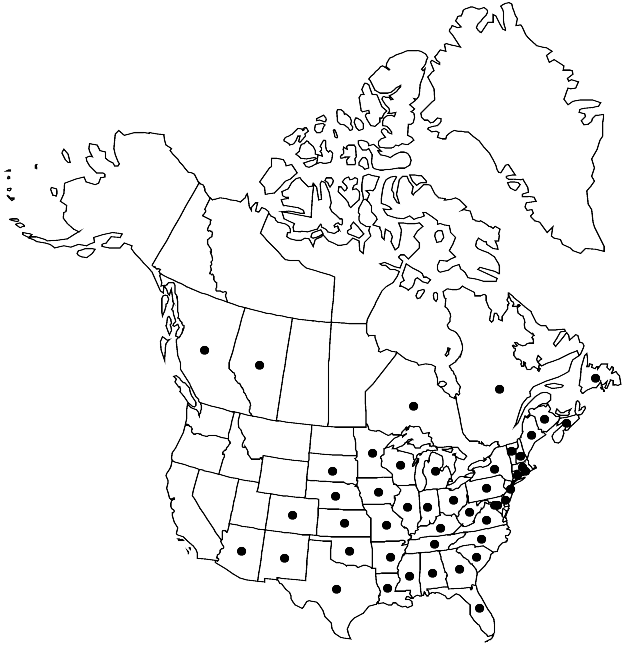Anomodon rostratus
Syn. Musc. Eur., 488. 1860.
Plants small, in thick, dense, mats, light to yellowish green. Stems 0.5–2 cm, 1 mm thick when dry, profusely branched, primary branches erect; central strand cells differentiated, smaller; pseudoparaphyllia absent; rhizoids few. Branch leaves julaceous, imbricate when dry, erect when moist, long-lanceolate, 0.8–1.4 mm; base broadly decurrent; margins revolute, entire; apex acuminate, ending in hair-point, intact; costa strong, ending well before apex, slightly obscured by laminal cells distally, pellucid, abaxial costa cells papillose, papillae thick, in 1 row; basal laminal cells hyaline, smooth, region in basal 1/2–2/3 of lamina; medial cells rhomboidal, 8–10(–12) µm, papillae many, slightly branched. Perichaetia distal to last branching nodes, leaves elongate, apex long-acuminate, laminal cells smooth. Seta 0.7–1.3 cm. Capsule elliptic, ovoid to oval-cylindric, urn 1–1.5 mm; stomata at base; annulus of 2 rows of cells; operculum obliquely rostrate, 0.8–1.1 mm; peristome well developed; exostome teeth regular, 0.2–0.3 mm, trabeculate, striolate to mid tooth or beyond, conspicuously papillose at apex; endostome well developed, basal membrane 7+ cells high, segments long, slender. Spores 11–15 µm, densely papillose.
Phenology: Capsules mature early-mid fall.
Habitat: Base or bark of deciduous trees, soil, fallen logs, deciduous forests, open spaces, secondary forests, vertical calcareous rock, occasionally acidic
Elevation: low to high elevations
Distribution

Alta., B.C., N.B., Nfld. and Labr. (Nfld.), N.S., Ont., Que., Ala., Ariz., Ark., Colo., Conn., Del., D.C., Fla., Ga., Ill., Ind., Iowa, Kans., Ky., La., Maine, Md., Mass., Mich., Minn., Miss., Mo., Nebr., N.H., N.J., N.Mex., N.Y., N.C., Ohio, Okla., Pa., R.I., S.C., S.Dak., Tenn., Tex., Vt., Va., W.Va., Wis., Mexico (Chiapas, Hidalgo, Nuevo León, Puebla, San Luis Potosí), West Indies (Hispaniola, Jamaica), Bermuda, Central America (Guatemala, Honduras), Europe.
Discussion
Anomodon rostratus forms dense and thick mats, often very extensive, with clustered stems in a pseudoverticillate branching pattern. This species is distinguishable from congeners in the short branch leaves, ending in a hyaline hair-point several cells long (to 0.2+ mm) and one cell thick. The leaf areolation is also more lax; the basal portion of rhomboid cells extends beyond 1/2 the leaf length. The species fruits frequently and abundantly in North America. Despite this, male gametophytes in North America are extremely scarce, even in populations fruiting profusely. The paucity of male plants is probably the reason why sporophytes are virtually unknown elsewhere.
Selected References
None.